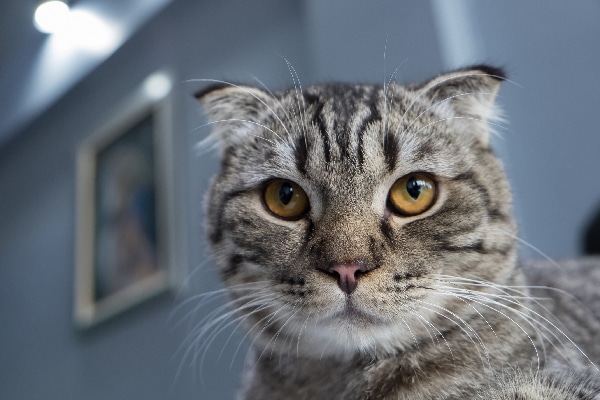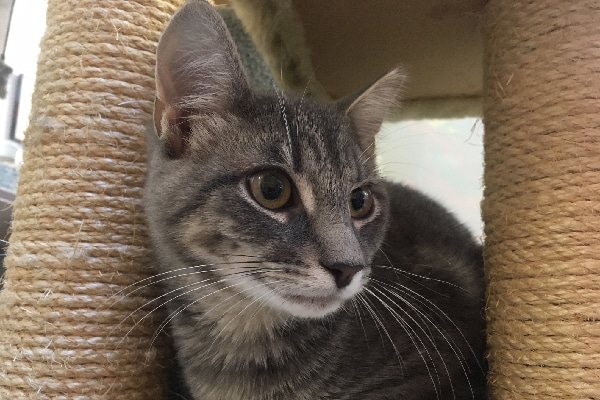5 Facts About the Gray Tabby Cat
The post 5 Facts About the Gray Tabby Cat by Denise LeBeau appeared first on Catster. Copying over entire articles infringes on copyright laws. You may not be aware of it, but all of these articles were assigned, contracted and paid for, so they aren't considered public domain. However, we appreciate that you like the article and would love it if you continued sharing just the first paragraph of an article, then linking out to the rest of the piece on Catster.com.
Of all the cats in the world of felines, the gray tabby cat is arguably one of the best-dressed kitties around. Gray tabbies sport that striking “M” on their foreheads like crowns. Remember — tabby is not a breed of cat, it’s a reference to a most recognizable coat pattern. The striped tabby motif appears on almost every type of cat from the ubiquitous Domestic Shorthair to the rarer Scottish Fold. Let’s learn some fun facts about the gray tabby cat!

Is he a gray — or grey — tabby cat? Photography © bebuntoon | iStock / Getty Images Plus.
1. Two Spellings and 50-Plus Shades of Gray
Is it gray tabby cat or grey tabby cat? According to Merriam-Webster, both spellings are correct for these two adjectives. Gray is the more popular spelling in the United States while grey is more prevalent in England. One mark of distinction for this fabulous feline is that Valspar has an interior paint color called Tabby Cat Gray! Gray is sometimes also referred to as blue — but let’s not split hairs.
2. Eye Colors
A gray tabby cat might have a variety of eye colors. And tabbies are also known to have brick red or gray pads on their paws. Genetics determine those tabby nose colors … but cat parents should know that cat noses can change color!
3. The Genes Behind a Gray Tabby Cat
Male cats get their coloring from their mother’s genes while female cats get a gene from each of their parents. Unlike orange tabby cats, gray tabbies can be found in both sexes equally. Tabby is considered a dominant trait, so it’s not surprising that the stripy tabby pattern is not only featured across breeds but also many members of community cat colonies boast the striking design.
The tabby stripes are also believed to be the best for camouflage. This strategic coat helped Felis catus survive on their own before becoming indispensable to the humble human. In fact, many of our house cat’s closest wild relatives hew to their tabby patterns. Lynx, the sand cat, Pallas’s cat and the Scottish wild cat are just a few whose appearance looks much like our domestic cat … but they’re best suited to hunt real prey, not catnip toys. And tabby is the coat of the “first” domesticated cats — the African wild cat, the Asiatic wild cat and the European wild cat. So, it only seems fitting that the tabby pattern is linked to the same genetics that give cheetahs their spots!

Timmy the gray tabby cat. Photography by Denise LeBeau.
4. A Gray Tabby Cat Makes a Good Housemate
As tabby patterns are prevalent across feline breeds, many community cats (a.k.a. feral cats) boast tabby coats. While there are some true feral felines who prefer to eschew human contact, many youngsters are friendlier to people. Or they simply come around because yummy food and a chin scratch feels pretty good. Partnerships between community cat caregivers and local shelters help save more cats’ lives. Through these partnerships, kittens get adopted into loving homes. Especially tabbies! I got to meet a sweet gray tabby cat named Timmy who represents all that’s wonderful about these partnerships and the stripy, tiny ghost tigers they rescue.
Timmy was accepted into the North Fork Animal Welfare League’s kitten program through a community cat caregiver. Its kitten room has a range of very friendly to extremely shy residents. Packing special salmon treats, I went into the room to see who could be plied with delicious goodies. Some kittens climbed right on my lap. Others would only accept a treat if it was tossed a safe distance away. But then there was Timmy, a gray tabby cat.
On his own, Timothy came up to my hand and sniffed cautiously. Within 30 seconds he was cheek rubbing my fingers with gusto. Then the unabashed kitty was head butting me like we were old friends. The Timster didn’t take any treats but continued to display affectionate behavior toward me, this invading stranger! Of the dozen or so kittens, Timmy was by far the friendliest and the only feline solely interested in human contact, and uninterested in soliciting fishy rewards. He’s not the first gray tabby cat that I’ve had the pleasure of playing with — I’d say they are among the most warm and loving cats around.
5. The Bottom Line on Gray Tabbies
Whether they’re from purebred origins or plucked off the streets, on the hunt for food or on the hunt for new friends, gray tabby cats have personalities that are as distinctive as their coats. They’re beautiful creatures on the outside and unique souls on the inside. It’s hard not to fall for a gray tabby cat. Adopting one, or two, gray tabbies is a surefire way to ensure there is a lot of love in your future.
Tell us: Do you have a gray tabby? What is he or she like?
Featured photograph: MassimoCattaneo | iStock / Getty Images Plus.
Read Next: 8 Questions About Calico Cats — Answered
The post 5 Facts About the Gray Tabby Cat by Denise LeBeau appeared first on Catster. Copying over entire articles infringes on copyright laws. You may not be aware of it, but all of these articles were assigned, contracted and paid for, so they aren't considered public domain. However, we appreciate that you like the article and would love it if you continued sharing just the first paragraph of an article, then linking out to the rest of the piece on Catster.com.




Post a Comment